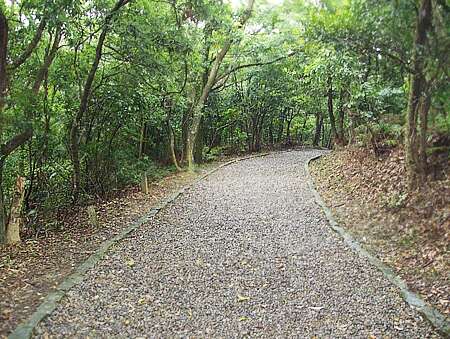Wuzhishan Mountain Range - Daluntou Weishan Ecological Trail Introduction
Dalun Mountain and Dalunwei Mountain are located on the main ridge extending west from the Wuzhishan mountain range, stretching northeast to southwest. Dalunwei Mountain rises to an elevation of 451 meters, with massive rocks arranged into peaks. Daluntou Mountain, at 475 meters, is the highest mountain in the Neihu area. The summit offers a broad view, making it an excellent spot to enjoy the landscape. The two mountains stand side by side, impressively commanding, and have become an important landmark in the Shilin Central community. The Dalun Mountain and Dalunwei Mountain Hiking Trail leads into the natural area. Due to the steep terrain and the protection of the water source area, Dalunwei Mountain has seen little development, allowing its natural ecology and flora to flourish. Entering from the trailhead in the Central community, one is greeted by a wide, flat gravel path bordered by tall trees, providing a cool and comfortable walk. The summit has a viewing platform from which you can overlook the surrounding areas of Waishuangxi and Yangmingshan. As the trail continues toward Daluntou Mountain, there is Dalun Lake situated halfway up the mountain, its emerald waters reflecting the surrounding scenery. On Bixian Road leading to Daluntou Mountain, autumn grasses sway gently in the breeze, creating a pleasant walking experience. To the north of the mountains, a natural trail connects to the Wankeng Industrial Road, with trails hidden in the forest alongside the lush woods of the Neishuangxi Forest Natural Park. The route to the forest features a spacious and comfortable wooden plank path elevated above the ground, which prevents harm to surface rocks and plants while also allowing visitors to observe nature. Informative signs appear at intervals, enhancing our understanding of the geological and ecological environment around us. Occasionally, trees appear to “pop out” from the path, having originally grown there, and the path has simply been constructed around them. In this way, the natural characteristics of the forest remain preserved while providing a convenient and comfortable trail for us, making it a win-win situation for everyone. The “indigenous” inhabitants of the forest maintain their living space, allowing for a lively environment full of insects and birds, with squirrels often spotted jumping among the trees. Despite ascending constantly, the rich ecology invites people to slow down, stopping to admire or consult the interpretive signs, making the entire journey feel relaxed and enjoyable without breathlessness. If one wants to take a break along the way, wooden platforms typically appear at bends in the trail, providing scenic views as well as rest areas. Rarely found in urban outskirts, there is a stretch of natural wooden planks approximately one kilometer long; seasoned hikers often choose to go barefoot for a refreshing experience in the forest. In addition to the diverse ecology, the entrance to the Free Hiking Trail toward Dalunwei Mountain offers an initial stretch of spacious, flat gravel road. The tall trees by the road sway in the wind, rustling leaves harmonizing with the sounds of footsteps on the gravel, enhancing the overall experience of wandering through the forest. Although most other segments consist of stone steps, the lush mountain forest remains a constant companion. Entering this ecological green corridor, the forest is mature and rich, as the hiking trail crosses the less-developed western foothills of Daluntou Mountain. Although Dalunwei Mountain lacks primary forest, its steep topography makes development difficult, combined with its location in a water source area, resulting in less human disturbance and better preservation of ecology. Between Daluntou Mountain and Dalunwei Mountain lies a windward slope that is constantly battered by strong winds, leading to noticeably shorter trees and forming a "wind-swept dwarf forest" composed of species such as red nanmu, Forest-style golden silk, big-leaf tea, and small-leaf red nanmu. The cold temperature effect caused by the northeast monsoon allows vegetation that typically grows at about 2,000 meters in altitude to thrive at over 400 meters, creating an exceptional phenomenon of altitudinal vegetation displacement. For example, deciduous plants like the water plantain and the liana thrive here just as they do in temperate regions. The summit area features warm temperate broadleaf forests, while the warmer valleys host typical plants such as buttress roots and epiphytic flowers found in tropical regions. Combined with the native subtropical broadleaf ecosystem, this results in a unique and rich compressed ecosystem encompassing tropical, subtropical, and warm temperate conditions. As the highest mountain in Neihu District, climbing Daluntou Mountain promises wonderful scenery. The viewing platform at the summit provides expansive views, with observation areas on both sides of the plaza. On the left, you can see Dalunwei Mountain and Shitoushan, while to the right, a small hillside reveals Yuanzai Mountain. From here, Dalunwei Mountain appears to be particularly grand, not merely a small peak of over 400 meters. Looking north, the Dacunshan mountain range forms a natural barrier with the clear volcanic cone of Shamao Mountain visible; across the valley, Pingdengli is a platform formed by lava flows during volcanic eruptions. At the other end, the scenery from Wuzhishan and the Neihu Dahu Park shows a picturesque reflection of the lake. Stretching across the Keelung River, mountains continuously reach towards Xizhi, Pingxi, Shiding, and Keelung. Near the summit of Dalunwei Mountain, there are many pavilions and observation areas for resting. The expansive summit platform features a simple viewing station that overlooks the scenery of Waishuangxi and Yangmingshan National Park. Descending a small staircase to a nearby platform by the tent can offer a different experience. Close to the summit, a large lookout platform provides a 360-degree panoramic view surrounding the undulating Wuzhishan mountain range and peaks toward Xizhi, evoking a sense of exhilaration akin to being on a ship, conquering the seas.



























